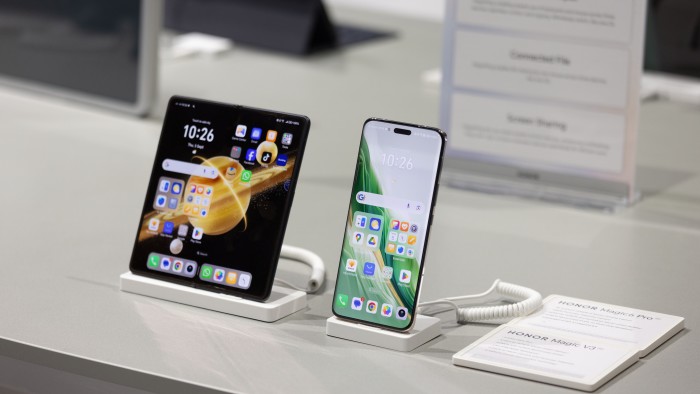China’s smartphone makers head upmarket in European push

Chinese smartphone manufacturers are intensifying efforts to gain a stronger foothold in Europe and sell higher-margin premium devices, with one of the world’s fastest-growing brands aiming to more than double its market share on the continent in the next three years.
Shenzhen-based Realme, which has increased European sales by 275 per cent from 2020 to last year, according to analysts, says it is targeting a market share of more than 10 per cent in the next three to five years, up from 4 per cent.
Currently the continent’s fourth biggest supplier, the handset maker became the fastest ever to reach 100mn global phone shipments in 2021 and the fifth fastest to reach 200mn last year, despite a slowdown in the smartphone market, according to research from Tech Insights and Counterpoint Research.
“If Realme can achieve success in the European market then our whole brand will be massively elevated and it will help our sales globally,” said Francis Wong, head of product marketing at the company. “Our whole strategy is to start from the low end and work our way up.”
However, he cautioned that marketing costs involved in selling to European customers loyal to Apple and Samsung were more than 10 times higher than in India, the company‘s first major market when it became an independent entity in 2018.

European consumers are less aware of Chinese brands and less concerned about value for money, meaning the company’s growth had so far been slower on the continent than in other markets, where it has doubled, tripled or quadrupled sales in just a few years, he added.
“We are used to that kind of rapid growth. So after coming to Europe, we found that this market is not as easy as we imagined,” said Wong.
Apple and Samsung still dominate in Europe, especially at the premium end, according to figures from Counterpoint. They accounted for 94 per cent of phones sold over $700 in the second quarter of this year. The last external challenger to claim close to 10 per cent of the European premium market was Huawei, which grew its share of sales rapidly until it was gradually pushed out by US sanctions and bans in some countries on the use of the company’s equipment in 5G networks from 2020.
Realme began life as an offshoot of Oppo, which itself was a brand owned by electronics group BKK. The Dongguan-based conglomerate also spawned phonemakers Vivo and Oneplus. Oppo, the world’s fourth-largest manufacturer by sales, saw its growth stunted by a legal battle with Nokia over patent rights in 2021, which forced it into a multiyear retreat from the continent.
But this year, Chinese smartphone makers say they are making renewed efforts to boost European sales, spotting an opportunity to win market share with new technologies such as foldable devices, advanced cameras and superfast chargers.
“We’ve seen Europe show a very open attitude towards embracing both foldables and flips . . . this is really a game-changer,” said Tony Ran, Europe president for Shenzhen-based Honor, adding that the continent was the company’s most important market outside China.
In the second quarter, Honor overtook Samsung to become the number one seller of foldable smartphones in western Europe, having entered the top five sellers in terms of overall European market share the previous quarter.
Ran said that 60 per cent of European buyers of foldable phones on the company’s online store had swapped over from “the duopoly” of Samsung or Apple devices. Honor’s flagship foldable Magic V3 phone is pitched at a premium price of around €2,000, comparable with the €1,979 price tag of the iPhone 16 Pro Max with 1TB storage.
Meanwhile, Oppo said last month it would launch its flagship Find X8 series in Europe, marking a high-profile return for its premium brand.
Billy Zhang, president for overseas marketing, sales and services said Oppo was “determined” to invest in the European market over the long term. Despite the challenges, he hoped consumers would slowly get used to the Oppo brand. “The first step is always painful,” he said.
Xiaomi, long the continent’s best-selling phonemaker behind Apple and Samsung, also increased its share of the premium market to 4.3 per cent in the third quarter of 2024, up from 2.7 per cent in the same period last year, according to figures from IDC.
In eastern Europe, previously lower-end challengers, such as Transsion, a Chinese manufacturer that dominates in Africa, have also increased their mid-end sales significantly.
Analysts caution that Chinese manufacturers have struggled to push their European market shares above about 4 per cent in recent years, while running up immense bills with aggressive marketing campaigns that include sponsorship of major sporting events such as the Champions League or French Open.
Realme’s market share growth, they added, was buoyed by sales in Russia, following Samsung and Apple’s exit after the full-scale invasion of Ukraine.
“For western Europe, they . . . invest a lot of money to build that brand awareness . . . but they don’t see a lot of positive returns,” said Will Wong, an analyst at IDC.
Smartphone makers argue that the prestige of making it in a developed market like Europe could help them in other high-end markets such as Japan, Australia and the US, potentially convincing operators to sell Chinese phones in those regions.
“We really have to think about it from a long-term perspective,” said Ran from Honor. “Once we can make it here, you can make it anywhere.”
#Chinas #smartphone #makers #upmarket #European #push







